高考英语语法-并列句和状语从句,题型全覆盖
- 格式:docx
- 大小:19.58 KB
- 文档页数:10
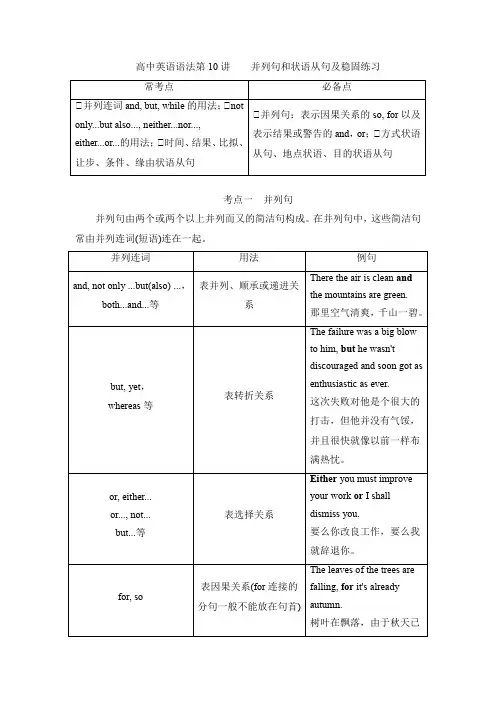
高中英语语法第10讲并列句和状语从句及稳固练习考点一并列句并列句由两个或两个以上并列而又的简洁句构成。
在并列句中,这些简洁句常由并列连词(短语)连在一起。
这/那时,突然……〞,常用于以下句式:sb be about to do/going to do/on the point of doing sth when...(某人刚要做某事,突然……), sb be doing sth when...(某人正在做某事,突然……), sb had (just) done sth when...(某人刚做完某事,突然……)。
He was about to go out when the telephone rang.他刚要出去时,铃响了。
He had just finished writing a report when the boss let him type a letter.他刚写完一篇报告,老板就让他打一封信件。
考点二状语从句(1)连词before的句型及意义:It will be some time (一段时间)+before ...,意为“多久以后才……〞;It won't be some time (一段时间)+before ...,意为“用不了多久就会……〞。
(2)连词since的句型及意义:It is some time (一段时间)+since引导的时间状语从句=It has been some time (一段时间)+since引导的时间状语从句,意为“自从……以来已经多长时间了〞。
(3)whether...or...意为“无论……还是……〞,引导让步状语从句。
(4)where引导地点状语从句。
稳固练习①.单句语法填空1.(2021·全国甲卷)We hired our bikes from the rental place at the South Gate. My bike was old and shaky but did the job.解析考查连词。
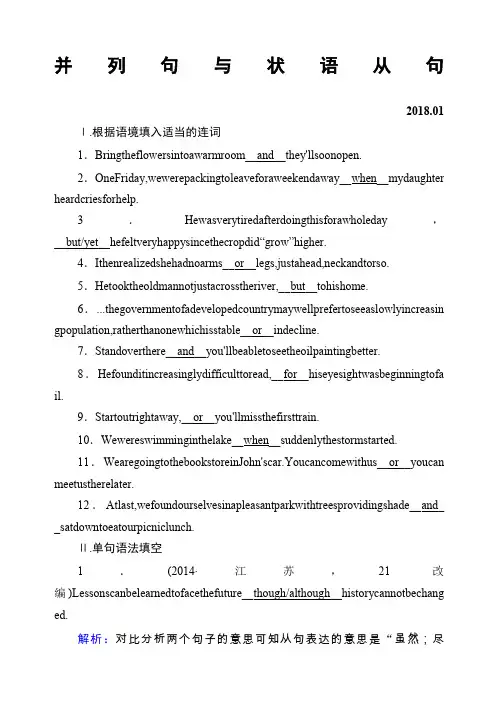
并列句与状语从句2018.01 Ⅰ.根据语境填入适当的连词1.Bringtheflowersintoawarmroom__and__they'llsoonopen.2.OneFriday,wewerepackingtoleaveforaweekendaway__when__mydaughter heardcriesforhelp.3.Hewasverytiredafterdoingthisforawholeday,__but/yet__hefeltveryhappysincethecropdid“grow”higher.4.Ithenrealizedshehadnoarms__or__legs,justahead,neckandtorso.5.Hetooktheoldmannotjustacrosstheriver,__but__tohishome.6....thegovernmentofadevelopedcountrymaywellprefertoseeaslowlyincreasin gpopulation,ratherthanonewhichisstable__or__indecline.7.Standoverthere__and__you'llbeabletoseetheoilpaintingbetter.8.Hefounditincreasinglydifficulttoread,__for__hiseyesightwasbeginningtofa il.9.Startoutrightaway,__or__you'llmissthefirsttrain.10.Wewereswimminginthelake__when__suddenlythestormstarted.11.WearegoingtothebookstoreinJohn'scar.Youcancomewithus__or__youcan meetustherelater.12.Atlast,wefoundourselvesinapleasantparkwithtreesprovidingshade__and_ _satdowntoeatourpicniclunch.Ⅱ.单句语法填空1.(2014·江苏,21改编)Lessonscanbelearnedtofacethefuture__though/although__historycannotbechang ed.解析:对比分析两个句子的意思可知从句表达的意思是“虽然;尽管”。
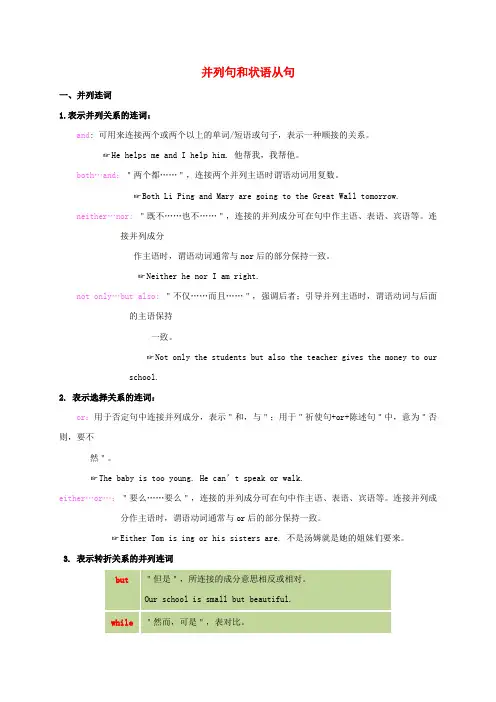
并列句和状语从句一、并列连词1.表示并列关系的连词:and: 可用来连接两个或两个以上的单词/短语或句子,表示一种顺接的关系。
☞He helps me and I help him. 他帮我,我帮他。
both…and:"两个都……",连接两个并列主语时谓语动词用复数。
☞Both Li Ping and Mary are going to the Great Wall tomorrow.neither…nor: "既不……也不……",连接的并列成分可在句中作主语、表语、宾语等。
连接并列成分作主语时,谓语动词通常与nor后的部分保持一致。
☞Neither he nor I am right.not only…but also: "不仅……而且……",强调后者;引导并列主语时,谓语动词与后面的主语保持一致。
☞Not only the students but also the teacher gives the money to our school.2. 表示选择关系的连词:or:用于否定句中连接并列成分,表示"和,与";用于"祈使句+or+陈述句"中,意为"否则,要不然"。
☞The baby is too young. He can’t speak or walk.either…or…:"要么……要么",连接的并列成分可在句中作主语、表语、宾语等。
连接并列成分作主语时,谓语动词通常与or后的部分保持一致。
☞Either Tom is ing or his sisters are. 不是汤姆就是她的姐妹们要来。
3. 表示转折关系的并列连词4. 表示因果关系的并列连词for :so : 4. when 可作并列连词,意为“正在这时”,表示某件事正在发生或刚刚发生时,突然发生另一动作。
⎩⎪⎨⎪⎧ be about to do...when...be doing...when...be on the point of doing...when...had just done...when...☞Tom was about to close the window when his attention was caught by a bird.汤姆正要关窗户,这时他的注意力被一只鸟吸引住了。
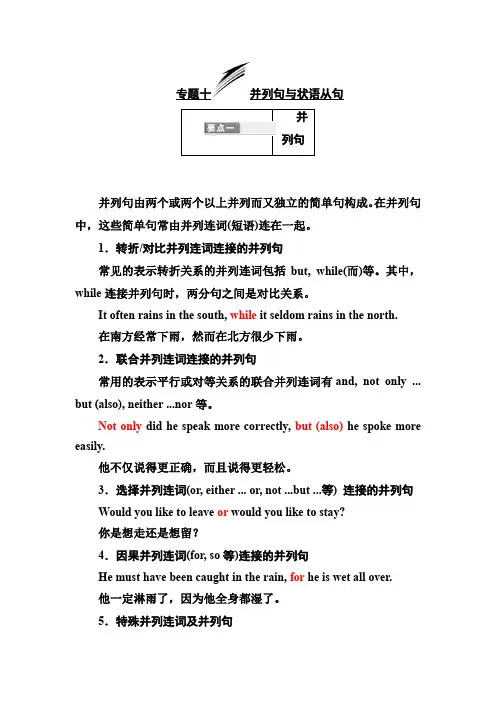
专题十并列句与状语从句并并列句由两个或两个以上并列而又独立的简单句构成。
在并列句中,这些简单句常由并列连词(短语)连在一起。
1.转折/对比并列连词连接的并列句常见的表示转折关系的并列连词包括but, while(而)等。
其中,while连接并列句时,两分句之间是对比关系。
It often rains in the south, while it seldom rains in the north.在南方经常下雨,然而在北方很少下雨。
2.联合并列连词连接的并列句常用的表示平行或对等关系的联合并列连词有and, not only ... but (also), neither ...nor等。
Not only did he speak more correctly, but (also) he spoke more easily.他不仅说得更正确,而且说得更轻松。
3.选择并列连词(or, either ... or, not ...but ...等) 连接的并列句Would you like to leave or would you like to stay?你是想走还是想留?4.因果并列连词(for, so等)连接的并列句He must have been caught in the rain, for he is wet all over.他一定淋雨了,因为他全身都湿了。
5.特殊并列连词及并列句(1)when可用于并列连词,意为“这时,那时”,相当于and at this/that time。
常用于下列句式:①be about to do sth. when ...“正要做某事,这时突然……”②be on the point of doing sth. when ...“正要做某事,这时突然……”③be doing sth. when ...“正在做某事,这时突然……”④had done sth. when ...“刚做了某事,这时突然……”He was about to go to school when a strong wind began to blow.他正要去上学,这时突然刮起了大风。
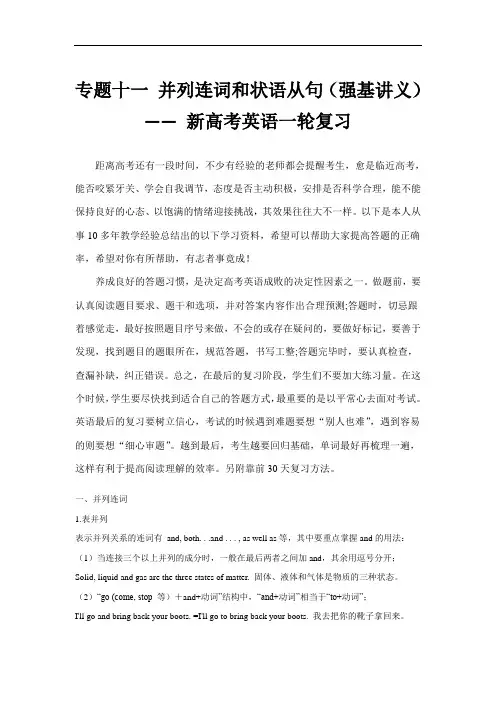
专题十一并列连词和状语从句(强基讲义)——新高考英语一轮复习距离高考还有一段时间,不少有经验的老师都会提醒考生,愈是临近高考,能否咬紧牙关、学会自我调节,态度是否主动积极,安排是否科学合理,能不能保持良好的心态、以饱满的情绪迎接挑战,其效果往往大不一样。
以下是本人从事10多年教学经验总结出的以下学习资料,希望可以帮助大家提高答题的正确率,希望对你有所帮助,有志者事竟成!养成良好的答题习惯,是决定高考英语成败的决定性因素之一。
做题前,要认真阅读题目要求、题干和选项,并对答案内容作出合理预测;答题时,切忌跟着感觉走,最好按照题目序号来做,不会的或存在疑问的,要做好标记,要善于发现,找到题目的题眼所在,规范答题,书写工整;答题完毕时,要认真检查,查漏补缺,纠正错误。
总之,在最后的复习阶段,学生们不要加大练习量。
在这个时候,学生要尽快找到适合自己的答题方式,最重要的是以平常心去面对考试。
英语最后的复习要树立信心,考试的时候遇到难题要想“别人也难”,遇到容易的则要想“细心审题”。
越到最后,考生越要回归基础,单词最好再梳理一遍,这样有利于提高阅读理解的效率。
另附靠前30天复习方法。
一、并列连词1.表并列表示并列关系的连词有and, both. . .and . . . , as well as等,其中要重点掌握and的用法:(1)当连接三个以上并列的成分时,一般在最后两者之间加and,其余用逗号分开;Solid, liquid and gas are the three states of matter. 固体、液体和气体是物质的三种状态。
(2)“go (come, stop 等)+and+动词”结构中,“and+动词”相当于“to+动词”;I'll go and bring back your boots. =I'll go to bring back your boots. 我去把你的靴子拿回来。
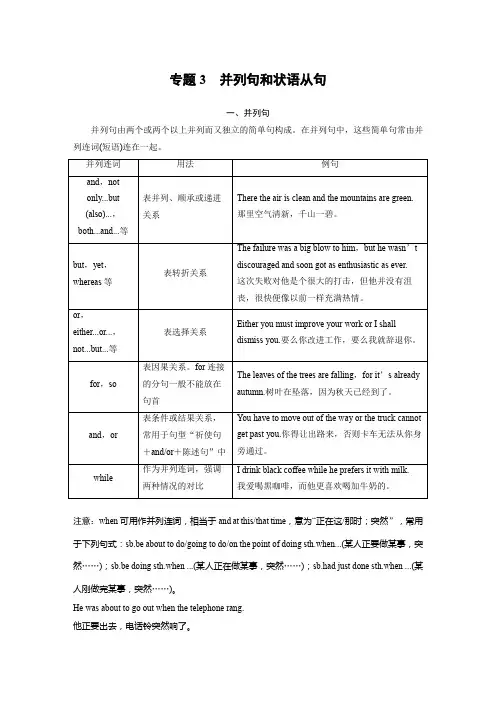
专题3并列句和状语从句一、并列句并列句由两个或两个以上并列而又独立的简单句构成。
在并列句中,这些简单句常由并列连词(短语)连在一起。
注意:when可用作并列连词,相当于and at this/that time,意为“正在这/那时;突然”,常用于下列句式:sb.be about to do/going to do/on the point of doing sth.when...(某人正要做某事,突然……);sb.be doing sth.when ...(某人正在做某事,突然……);sb.had just done sth.when ...(某人刚做完某事,突然……)。
He was about to go out when the telephone rang.他正要出去,电话铃突然响了。
He had just finished writing a report when the boss let him type a letter.他刚写完一篇报告,老板就让他打印一封信件。
单句语法填空1.At school,some students are active while some are shy,yet they can be good friends with one another.2.The other day I was doing some grocery shopping when a man walked toward a group of us at the checkout stand.3.Follow your doctor’s advice,or your cough will get worse.4.John plays basketball well,but/yet his favorite sport is badminton.二、状语从句考点一让步状语从句单句语法填空1.The athletes,especially the winners,should remain modest whatever rapid progress they have made.2.Much as/though I have traveled,I have never seen anyone who’s as capable as John. 3.Don’t trust him,no matter what he says.4.While/Although/Though I admit that there are problems,I don’t agree that they cannot be solved. 5.I’ll do it,even if/though it takes me all the afternoon.6.We’ll go on with the work,whether we can find the necessary tools or not.7.No matter how hard the work is,you’d better try to do it well.考点二时间状语从句单句语法填空1.Not until we succeed in letting wildlife live in peace can we smile in relief.2.Air pollution is getting more and more serious,so we must take action before it is too late. 3.He had no sooner finished his speech than the students started cheering.4.While watching TV,children do not merely absorb words and images.5.As he grew older,he became less active.考点三地点状语从句和条件状语从句单句语法填空1.Well,I’m working on a huge assignment and if I don’t do well,that will ruin my reputation as an excellent accountant!2.He will never make progress in math unless he really wants to learn it.3.Wherever she goes,there are crowds of people waiting to see her.4.Supposing/Suppose(suppose) that they refuse us,who else can we turn to for help?5.They agreed to lend us the car on condition that we returned it before the weekend.6.My parents don’t mind what job I do as long as I am happy.考点四其他状语从句单句语法填空1.If the guests are seated at the table,the hosts may serve the food,or it may be passed so that each person may help himself.2.Enjoying a fresh morning is important because/as it can set the mood for the rest of the day. 3.And he speaks so slowly and strangely that it takes patience to understand what he is saying. 4.They treat her as though/if she were their daughter.状语从句的省略1.时间、让步、方式、地点状语从句的省略如果状语从句的主语与主句的主语一致或从句的主语是it,而且状语从句的谓语中有be动词,可以将从句中的主语连同be动词一起省略。
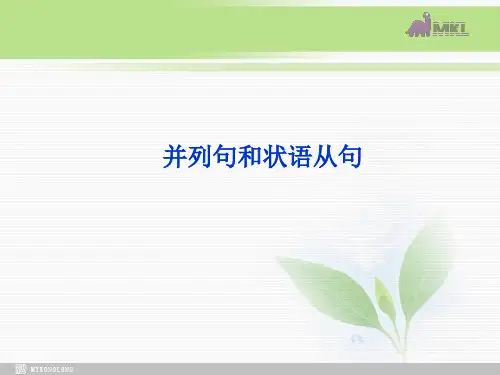
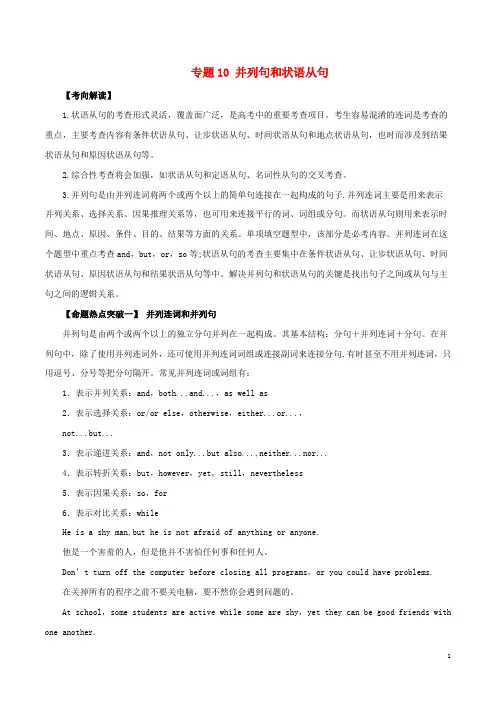
专题10 并列句和状语从句【考向解读】1.状语从句的考查形式灵活,覆盖面广泛,是高考中的重要考查项目。
考生容易混淆的连词是考查的重点,主要考查内容有条件状语从句、让步状语从句、时间状语从句和地点状语从句,也时而涉及到结果状语从句和原因状语从句等。
2.综合性考查将会加强,如状语从句和定语从句、名词性从句的交叉考查。
3.并列句是由并列连词将两个或两个以上的简单句连接在一起构成的句子.并列连词主要是用来表示并列关系、选择关系、因果推理关系等,也可用来连接平行的词、词组或分句。
而状语从句则用来表示时间、地点、原因、条件、目的、结果等方面的关系。
单项填空题型中,该部分是必考内容。
并列连词在这个题型中重点考查and,but,or,so等;状语从句的考查主要集中在条件状语从句、让步状语从句、时间状语从句、原因状语从句和结果状语从句等中。
解决并列句和状语从句的关键是找出句子之间或从句与主句之间的逻辑关系。
【命题热点突破一】并列连词和并列句并列句是由两个或两个以上的独立分句并列在一起构成。
其基本结构:分句+并列连词+分句。
在并列句中,除了使用并列连词外,还可使用并列连词词组或连接副词来连接分句.有时甚至不用并列连词,只用逗号、分号等把分句隔开。
常见并列连词或词组有:1.表示并列关系:and,both...and...,as well as2.表示选择关系:or/or else,otherwise,either...or...,not...but...3.表示递进关系:and,not only...but also...,neither...nor...4.表示转折关系:but,however,yet,still,nevertheless5.表示因果关系:so,for6.表示对比关系:whileHe is a shy man,but he is not afraid of anything or anyone.他是一个害羞的人,但是他并不害怕任何事和任何人。
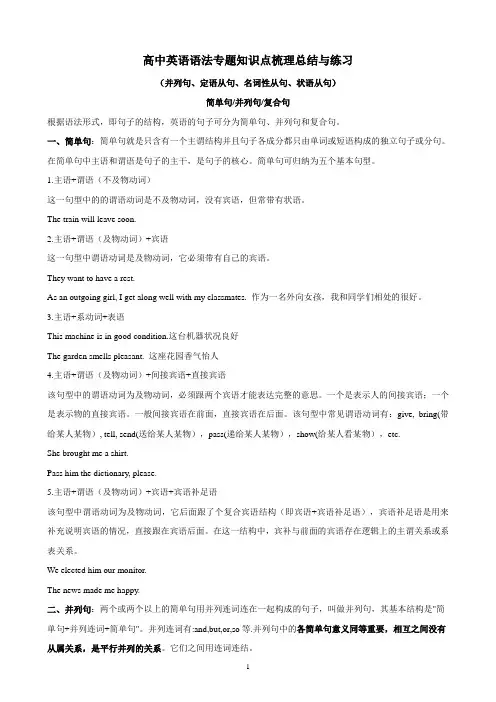
高中英语语法专题知识点梳理总结与练习(并列句、定语从句、名词性从句、状语从句)简单句/并列句/复合句根据语法形式,即句子的结构,英语的句子可分为简单句、并列句和复合句。
一、简单句:简单句就是只含有一个主谓结构并且句子各成分都只由单词或短语构成的独立句子或分句。
在简单句中主语和谓语是句子的主干,是句子的核心。
简单句可归纳为五个基本句型。
1.主语+谓语(不及物动词)这一句型中的的谓语动词是不及物动词,没有宾语,但常带有状语。
The train will leave soon.2.主语+谓语(及物动词)+宾语这一句型中谓语动词是及物动词,它必须带有自己的宾语。
They want to have a rest.As an outgoing girl, I get along well with my classmates. 作为一名外向女孩,我和同学们相处的很好。
3.主语+系动词+表语This machine is in good condition.这台机器状况良好The garden smells pleasant. 这座花园香气怡人4.主语+谓语(及物动词)+间接宾语+直接宾语该句型中的谓语动词为及物动词,必须跟两个宾语才能表达完整的意思。
一个是表示人的间接宾语;一个是表示物的直接宾语。
一般间接宾语在前面,直接宾语在后面。
该句型中常见谓语动词有:give, bring(带给某人某物), tell, send(送给某人某物),pass(递给某人某物),show(给某人看某物),etc.She brought me a shirt.Pass him the dictionary, please.5.主语+谓语(及物动词)+宾语+宾语补足语该句型中谓语动词为及物动词,它后面跟了个复合宾语结构(即宾语+宾语补足语),宾语补足语是用来补充说明宾语的情况,直接跟在宾语后面。
在这一结构中,宾补与前面的宾语存在逻辑上的主谓关系或系表关系。
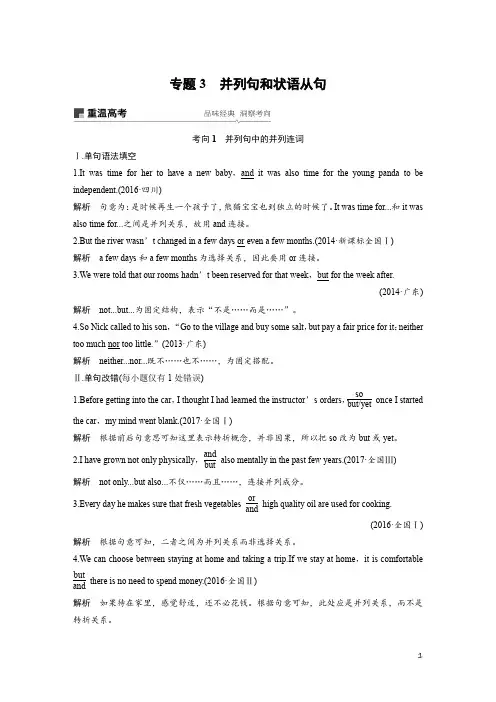
专题3并列句和状语从句考向1并列句中的并列连词Ⅰ.单句语法填空1.It was time for her to have a new baby,and it was also time for the young panda to be independent.(2016·四川)解析句意为:是时候再生一个孩子了,熊猫宝宝也到独立的时候了。
It was time for...和it was also time for...之间是并列关系,故用and连接。
2.But the river wasn’t changed in a few days or even a few months.(2014·新课标全国Ⅰ)解析 a few days和a few months为选择关系,因此要用or连接。
3.We were told that our rooms hadn’t been reserved for that week,but for the week after.(2014·广东) 解析not...but...为固定结构,表示“不是……而是……”。
4.So Nick called to his son,“Go to the village and buy some salt,but pay a fair price for it:neither too much nor too little.”(2013·广东)解析neither...nor...既不……也不……,为固定搭配。
Ⅱ.单句改错(每小题仅有1处错误)1.Before getting into the car,I thought I had learned the instructor’s orders,sobut/yet once I started the car,my mind went blank.(2017·全国Ⅰ)解析根据前后句意思可知这里表示转折概念,并非因果,所以把so改为but或yet。
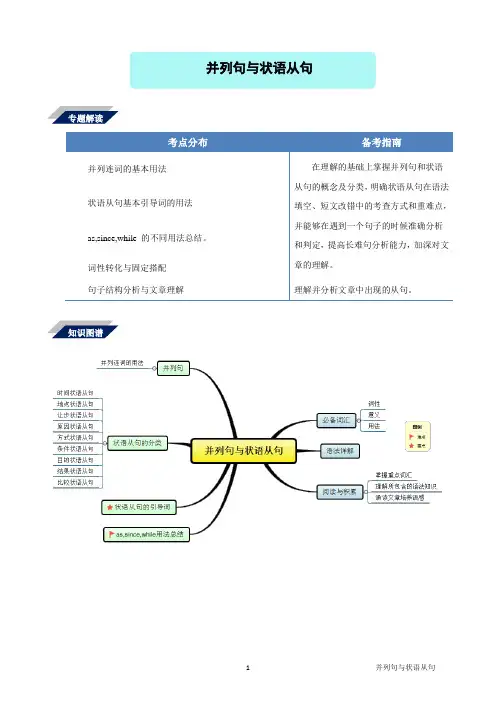
考点分布备考指南并列连词的基本用法在理解的基础上掌握并列句和状语从句的概念及分类,明确状语从句在语法填空、短文改错中的考查方式和重难点,并能够在遇到一个句子的时候准确分析和判定,提高长难句分析能力,加深对文章的理解。
状语从句基本引导词的用法as,since,while 的不同用法总结。
词性转化与固定搭配 句子结构分析与文章理解理解并分析文章中出现的从句。
专题解读知识图谱并列句与状语从句deep adj.深的breath n.呼吸count v.数mark n.分数;标志v.打分;做标记experience n.&v.经验(不可数);经历(可数)competition n.竞争;竞赛take off ①起飞;②脱下(反义)put onwonderful adj.绝妙的;了不起的kind n.种类adj.好心的abroad adv. 在(到)国外entertainment n.娱乐time n.次数(可数),时光(不可数)latest adj.最近的;最新的discover v.发现environment n.环境grow n.&v.生长;种植;变得universal adj.宇宙的,普遍的,通用的light n.光线;电灯adj.轻的,少的alone adj.孤单的;孤独的(作表语)cost (cost,cost) v.价钱为;花费知识清单必备词汇语法详解之并列句由并列连词将两个或两个以上平等关系的简单句连接在一起构成的句子叫并列句。
其结构是:简单句+并列连词+简单句一、并列关系常用的连词有and(同,和), when(=and just at this time就在这时,然后), not only…but (also)…(不仅……而且……), neither…nor…(既不……也不……)等。
如:He helps me and I help him.他帮我,我帮他。
He not only gave us a lot of advice, but also helped us to study English. 他不仅给我们出很多建议并且还帮助我学英语。
定额市鞍钢阳光实验学校专题十状语从句和并列句常考点状语从句是一项较大的语法项目,也是近几年高考题中常见的一个重要试点。
由从句担任的状语,在句子中可修饰谓语(或其他动词)、形容词、副词或是整个句子。
一般可分为九大类,分别表示时间、地点、原因、目的、结果、条件、让步、比较和方式。
尽管种类较多,但由于状语从句与汉语结构和用法相似,所以理解和掌握它并不难。
掌握状语从句的关键是要掌握引导不同状语从句的常用连接词和特殊的连接词。
1状语从句中从属连词when,while,as的多种含义when:当……时候;就在那时;既然;虽然;在……之后;as:一边……一边;随着;虽然;因为;依照,如……;while:在……期间;而;虽然。
用when,while和as填空:①He will take my place ________ I am away.②I was having my lunch ________ the fire alarm went off.③________ you have finished your work,you may have a rest.④________ he swam,he cried for help.⑤________ the Internet is of great help,I don't think it good to spend too much time on it.【答案】①while②when③When④As⑤While2as引导让步状语从句as引导让步状语从句时要倒装,若是倒装,需将所强调的成分即名词(句首名词不能有任何冠词)、形容词、副词、分词、实义动词提前。
[注]①though引导状语从句可以倒装也可以不倒装,although不能引起倒装。
②as,though,although引导从句时,后面的主句不能有but,但可以和still,yet连用。
完成下列句子:①________________(虽然他是个孩子),he knows what is the right thing to do.②________________(虽然他工作很努力),he never seemed able to do the work satisfactorily.③_______________(虽然你可能失败),you should never give up.【答案】①Child as he is②Hard as he worked③Fail as you may 3before的用法注意判断before在状语从句中的含义:才;就;趁……没有;还没来得及;宁可……也不;不知不觉。
高考英语语法真题详解-并列句和状语从句[感悟高考]单句语法填空/单句改错1.In much of Asia,especially the so-called “rice bowl” cultures of China,Japan,Korea, ________ Vietnam,food is usually eaten with chopsticks.(2016·全国Ⅲ,41)2.Over time, ________ the population grew,people began cutting food into small pieces so it would cook more quickly.(2016·全国Ⅲ,45)3.Though not very big,but the restaurant is popular in our area.(2016·全国Ⅰ,短文改错)4.If we stay at home,it is comfortable but there is no need to spendmoney.(2016·全国Ⅱ,短文改错)5.There the air is clean or the mountains are green.(2015·全国Ⅰ,短文改错)答案 1.and 2.with 3.去掉but 4.but→and 5.or→and[考点清单]考点一并列句4种类型的考查规则❶表并列、递进或顺承关系:and,both...and...,neither...nor...,not only...but also...Not only did he speak more correctly but (also) he spoke more easily.他不仅说得更正确了,而且说起来也更容易了。
规则❷表转折、对比关系:but,yet,whileThe winter in Beijing is very cold while that of Kunming is warm.北京的冬天很冷,然而昆明的冬天却很暖和。
高三英语(课标全国卷)并列句和状语从句1. 掌握并列连词的基本用法及句式。
2. 掌握状语从句从属连词的基本用法。
一、并列句并列连词连接两个互不依存的词、短语或分句。
并列连词连接两个分句就构成了并列复合句。
(一)并列句思维导图(二)表示顺承或递进关系:and,both.. and..., not only..but (also)., as well as, neither...nor...等。
1. and;①意为“和,与,且,又”,表顺承、递进关系;②表示动作长时间地“继续”或“重复”。
Local people live in old houses and they are very friendly.当地人生活在旧房子里并且他们很友好。
We waited and waited.我们等了又等。
2. both…and…意为“既……又……,两个都”。
He spoke with both kindness and understanding. 他说话既亲切又明事理。
3. not only…but(also)….意为“不仅……而且.….…”。
Not only men but (also) women were chosen. 选中的不仅有男性还有女性。
4. as well as 意为“也,还”。
They have a flat in town as well as in the countryside. 他们在城里有一套公寓,在乡村也有。
5. neither….nor…意为“既不……也不……”。
Neither Tom nor Helen is hard-working. 汤姆和海伦都不勤奋。
(三)表示转折或对比关系:but,yet, not... but…,while 等。
1. but意为“但,而,然而”,表示转折关系,不能与从属连词 although, though, while 连用。
There are many kinds of sports, but my favorite is swimming. 有许多种运动,但我最喜欢的是游泳。
2021年高考英语语法复习:并列句和状语从句一、并列句考点一常见并列句的类型及并列连词Both Peter and Tom are from South Africa.彼得和汤姆都来自南非。
First,my English is very good and I’m open-minded and warm-hearted,so I’m getting along well with everyone.首先,我的英语很好,而且我性格外向、很热心,因此我和每个人都相处得很好。
He tried hard to catch up with his classmates,but he failed.他尽力赶上同学们,但是失败了。
The children can go with us,or they can stay in.孩子们可以跟我们去,也可以待在家里。
He must have been caught in the rain,for he is wet all over.他肯定被雨淋了,因为他浑身都湿了。
考点二并列连词构成的常用句型1.and构成的句型(1)祈使句+and+陈述句(祈使句相当于一个条件状语从句,and后面的句子相当于一个表示结果的主句)。
Go on like this and I am sure you will be successful in time.继续这样努力,我确信你最终会成功的。
(2)名词(词组)+and+陈述句(名词相当于一个条件状语从句,其中常含有more,another等词)。
Another try,and you’ll make a success.再试一次,你就会取得成功。
2.or (else)构成的句型(1)祈使句+or (else)+陈述句。
Seize the chance,or (else) you’ll regret.抓住这次机会,否则你会后悔的。
(2)名词(词组)+or (else)+陈述句。
距离高考还有一段时间,不少有经验的老师都会提醒考生,愈是临近高考,能否咬紧牙关、学会自我调节,态度是否主动积极,安排是否科学合理,能不能保持良好的心态、以饱满的情绪迎接挑战,其效果往往大不一样。
以下是本人从事10多年教学经验总结出的以下学习资料,希望可以帮助大家提高答题的正确率,希望对你有所帮助,有志者事竟成!养成良好的答题习惯,是决定高考英语成败的决定性因素之一。
做题前,要认真阅读题目要求、题干和选项,并对答案内容作出合理预测;答题时,切忌跟着感觉走,最好按照题目序号来做,不会的或存在疑问的,要做好标记,要善于发现,找到题目的题眼所在,规范答题,书写工整;答题完毕时,要认真检查,查漏补缺,纠正错误。
总之,在最后的复习阶段,学生们不要加大练习量。
在这个时候,学生要尽快找到适合自己的答题方式,最重要的是以平常心去面对考试。
英语最后的复习要树立信心,考试的时候遇到难题要想“别人也难”,遇到容易的则要想“细心审题”。
越到最后,考生越要回归基础,单词最好再梳理一遍,这样有利于提高阅读理解的效率。
另附高考复习方法和考前30天冲刺复习方法。
考点一:并列句1、技法巧图解2. 高考真题体验1、(2022年新高考I卷)...After a three-year pilot period, the GPNP will be officially set up nextyear. The GPNP is designed to reflect the guiding principle of “protecting the authenticity and integrity (完整性) of natural ecosystems, preserving biological diversity, protecting ecological buffer zones, ______ leaving behind precious natural assets(资产)for future generations”. (用适当的词填空)【详解】考查连词。
高考英语语法-并列句和状语从句,题型全覆盖Ⅰ. 单句语法填空1.Lessons can be learned to face the future __though/although__history cannot be changed.解析:对比分析两个句子的意思可知从句表达的意思是“虽然;尽管”。
句意为:虽然历史不能被改变,但是可以学习经验来面对未来。
设空处引导让步状语从句,故填though/although。
2.You will never gain success __unless__you are fully devoted to your work.解析:根据句意可知主从句间是条件关系,且对比分析两句话间“主将从现”的时态及主句中的否定词never可知用表条件的unless(if...not)。
句意为:除非你完全投入到你的工作中,否则你永远无法取得成功。
3.He is a shy man,__but__he is not afraid of anything or anyone.解析:but用来连接并列但语义对比的两个句子。
句意:他是个腼腆的人,但他并不怕任何事或任何人。
4.__Once__the damage is done, it will take many years for the farmland to recover.解析:once一旦。
句意:一旦造成损害,土地要好多年才能恢复。
5.We need to get to the root of the problem__before__we can solve it. 解析:本题考查状语从句的连词。
before表示“主句发生在从句之前”。
句意:在我们解决问题之前,我们需要找到问题的根源。
6.__Although/Though__the job takes a significant amount of time,most students agree that the experience is worth it.解析:although/though虽然(表示“虽然”时,不在后面使用连词but,不过有时它可与yet,still,nevertheless等副词连用)。
句意:虽然那个工作要花大量的时间,但是大多数学生都觉得这次经历是值得的。
7.That's why I help brighten people's days.If you__don't__,who's to say that another person will?解析:考查if引导的条件状语从句。
在if引导的条件状语从句中,如果从句谈论的是一个有可能发生的事实及其产生的相关的结果,主句用一般将来时态,从句用一般现在时态。
此句中的who's to say that another person will用的是将来时,故if引导的条件状语从句要用一般现在时。
句意:这就是为什么我要使人们的日子变得鲜活起来。
如果你不这样做,你说谁会这样做?8.There is only one more day to go__before__your favorite music group play live.解析:before意为“在……之前”。
句意:离你最喜欢的乐队的现场演奏只剩下一天了。
9.If you miss this chance,it may be years __before__ you get another one.解析:It be+时间段+before...“要过……才会……”。
句意:如果你错过这次机会,可能要等很多年才会再有另一个机会。
10.It is so cold that you can't go outside__unless__fully covered in thick clothes.解析:本题考查状语从句引导词及状语从句的省略。
句意:天如此冷以至于你除非完全包裹着厚衣服,否则不能外出。
unless除非。
unless从句中省略主语you 及系动词are。
11. It's a motto that we should never remember the benefit we have offered __nor__ forget the favor received.解析:句意为:我们应当永远不要记挂我们所给予的好处也不要忘记我们所受的恩惠。
这是一则座右铭。
nor为表示否定含义的并列词,never...nor...表示“既不……也不……”。
12.Ask any Chinese which city in China is famous for ice and snow,__and__ the answer is sure to be Harbin.解析:句意为:(如果)你问任何一个中国人中国的哪座城市因冰雪而出名,答案一定是哈尔滨。
此处为“祈使句+and/or+陈述句”的结构,两个分句之间为顺承关系,故填and。
13.Stick to what you think is right, __and__ you will gain a surprising happy ending.解析:句意为:坚持你认为正确的,你会拥有一个幸福的结局。
此处为“祈使句+and/or+陈述句”的结构,两个分句之间为顺承关系,故填and。
14.—Can I lie about seeing a text message because I was too busy or lazy to respond to it?—Receiving a text message does not necessarily mean you have to respond. Why waste a perfectly good lie __when__ the truth will serve? 解析:句意为:——当我很累或懒得去答复时,我可以撒谎说没看过短信吗?——收到短信并不一定意味着必须回复。
为什么非得滥用一个精心编造的谎言而不去说实话呢?对比分析主从句谓语的动作可知是同时发生,因此用时间状语连词when表示“当……时候”。
15.Though it has been one year __since__ he came to the city, he knows every street here like the back of his hand.解析:句意为:尽管他来这座城市仅仅一年,但是他对这儿的每条街道了如指掌。
本题考查固定句型“it has been+时间段+since...”,表示“自从……已经多久了”。
16.—What did he think of the trip to Beijing last month?—He had such a good time __when__ he visited the Great Wall.解析:句意为:——他认为上个月的北京之行怎么样?——当他去参观长城时玩得很开心。
设空处引导时间状语从句,表示“当……时候”,故填when。
本题容易误用成“such...that...”结构。
17.Little __as/though__ he knew about classical music, he pretended to be an expert on it.解析:句意为:尽管他对古典音乐了解很少,但他假装对此是名专家。
分析句意及句子结构可知,设空处所在分句为让步状语从句,且否定词little位于句首,应用倒装结构,故填as或though。
although也表“尽管”,但其引导的从句要用正常语序,故不填。
18.People in Dali are very friendly and honest to you __whether__ you are a foreigner or just a local.解析:句意为:大理的人对你很诚实而友好,无论你是外地人还是当地居民。
whether...or...表示“无论是……还是……”,引导让步状语从句。
19.You can smoke here __if__ you leave a window open to let the smoke out.解析:句意为:如果你留一扇窗户使烟散发出去,你就可以在这里吸烟。
根据句意可知,此处为条件状语从句,表示“如果”,故填if。
20.Just__as__ a single word can change the meaning of a sentence,a single sentence can change the meaning of a paragraph.解析:句意为:正如单独一个词能改变一个句子的含义一样,一个独立的句子也能改变一个段落的含义。
just as意为“正如,正像”,符合句意。
Ⅱ. 语法填空在空白处填入适当的内容(1个单词)或括号内单词的正确形式。
My classmate Michael studied very hard __1. after__ he went to senior school. Every day he worked __2. until__ every one left the classroom. He said he wouldn't stop trying __3. unless__ he got satisfying scores in his studies. Hard __4. as/though__ he tried, he made little progress, but he didn't lose heart at all __5. because__ he believed as long as he persisted he would succeed one day. __6. As__ time went by, he made improvements in his studies and he was admitted to a university in Guangzhou at last. We had a get-together party __7. before__ we started our new life in university. __8. Since__ everyone had got offers from universities, we had a very good time. When we stood __9. where__we used to play and study, we couldn't help thinking of our happy old days. We believed we would never forget each other, __10. wherever__ we would go or whatever we would do. Before we departed, __11. although/though__we seemed a little sadder __12. than__before, we still fought back the tears.Ⅲ. 单句改错1.But no sooner had I left when the bus arrived.答案与解析:when→than no sooner...than...“刚……就……”,是固定用法。